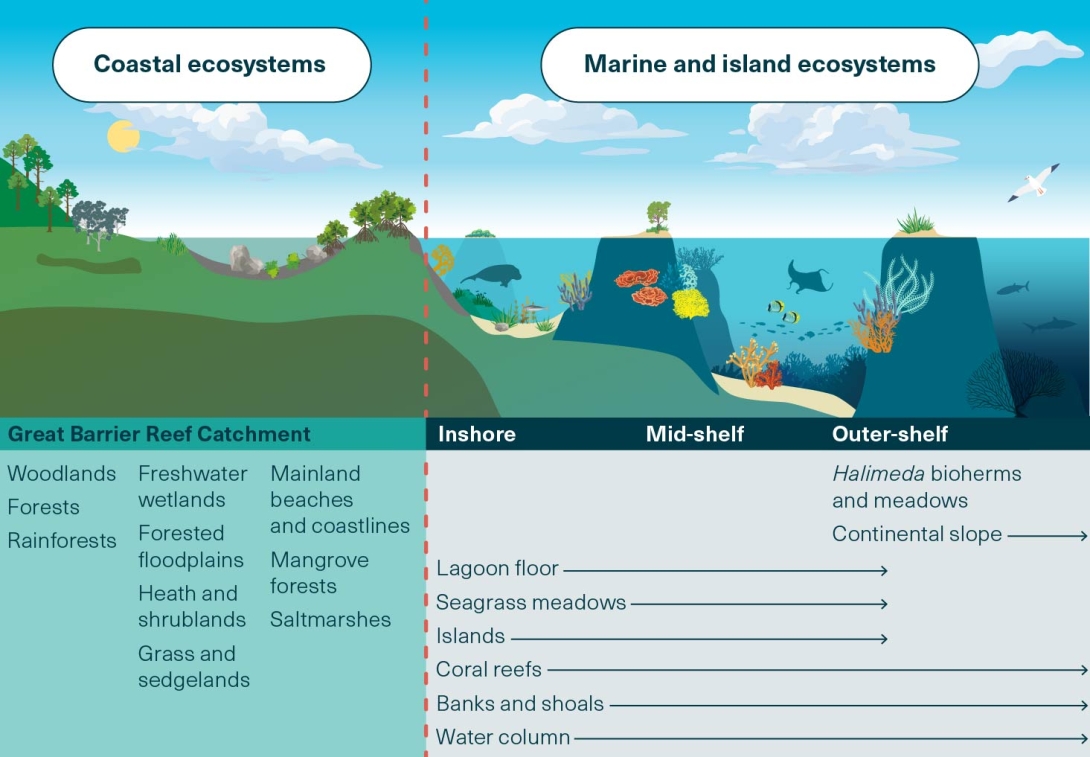Biodiversity refers to the variety of living things in an area, including plants, animals and microbes, and their unique genetic information.14 It is a fundamental component of ecosystem resilience (Chapter 8). The Great Barrier Reef is the largest coral reef ecosystem in the world and remains one of the world’s most diverse and remarkable ecosystems. The biodiversity of the Reef underpins its rich and complex ecosystem, conferring a range of benefits to the Reef itself and to the industries and communities that depend on it for their livelihoods and wellbeing.
The Reef remains one of the world’s most diverse and remarkable ecosystems
The Reef is not just a natural wonder, recognised for its outstanding universal value as a World Heritage–listed property. It is also a place of spiritual and cultural importance to the First Nations peoples who have lived in the Region for thousands of years.15,16 The many and varied forms of life that make up the Reef have sustained Traditional Owners for millennia, and they carry special significance expressed through song, dance, music, and cultural artefacts (Chapter 4).
A place of spiritual and cultural importance to First Nations peoples
Despite its importance and the wealth of information available for some species and habitats, knowledge of much of the biodiversity on the Reef,17 and in tropical marine ecosystems more generally, remains limited.18,19 Rapid advances in technologies, including genome sequencing, are beginning to shed light on the unknown biodiversity of the Reef (see Box 2.1).
Figure 2.1
Major habitats that comprise the overarching ecosystems of the Reef and Catchment
A wide variety of habitats make up the Reef’s coastal and marine ecosystem. The most pronounced
variation is across the continental shelf from the inshore coastal habitats, such as mangroves and
beaches, eastwards to the continental slope and deep ocean.

The assessment in this chapter focuses on the broad habitats that make up the Region’s ecosystem (Figure 2.1), and the species and groups of species supported by these habitats. It is important to note that these habitats and processes function at a hierarchy of scales,33,34 in both space and time. Consideration has been given to the relevance of observed change over the past 5 years in the context of variability expected over widely varying timescales, from days to the many centuries over which the modern Reef has formed. Beaches, coastlines, and island habitats outside the Region are considered to the extent that they influence the values within the Region. Assessments of condition and trends in condition for coastal ecosystems that support the Reef are presented in Chapter 3.
Box 2.1
The genomics revolution: insights into Great Barrier Reef diversity and resilience
Continuing rapid advances in genomics (sequencing and analysing an organism’s genetic code) are providing new insights into biodiversity and the ability of species to cope with the impacts of climate change.14 For example, genomic studies are revolutionising the way scientists understand the relationships of corals with their symbiotic microorganisms.20 Genomic techniques are being used to challenge traditional understanding of coral taxonomy, and they have led to the discovery of new species, including cryptic species that are morphologically indistinguishable from previously recognised corals.21 These findings suggest that coral diversity is even greater than previously thought.22
Environmental DNA (eDNA) analysis is a molecular technique that involves collecting samples from physical environments and using genetic markers to identify the presence of distinct species. eDNA is an emerging tool with wide-ranging applications.14,23 Examples include the monitoring of rare, cryptic, and elusive species 23 (such as assessing benthic species of the lagoon floor 24) and the potential early detection and monitoring of invasive species 25 (such as invasive ants on Reef islands).26 These techniques may allow researchers to assess species assemblages quickly and relatively inexpensively. However, limitations on their application remain 23 because an adequate library of well-curated reference sequences for most species is currently lacking, and there are constraints in current genomic methods and analyses.14,27
Genomic data are also providing insights into the potential impacts of climate change on corals by identifying the way corals respond to stress at the molecular level 28 and the ability of corals to adapt in the face of rapid environmental change.29 This is enabling the identification of coral species and populations with greater resistance to environmental stressors.30,31 These resilient organisms could be vital to ensure the survival of coral reefs in a changing climate and in the development of new approaches to coral conservation and restoration.32
*The copyright attribution has been updated on this website subsequent to tabling of the 2024 Great Barrier Reef Outlook Report.


